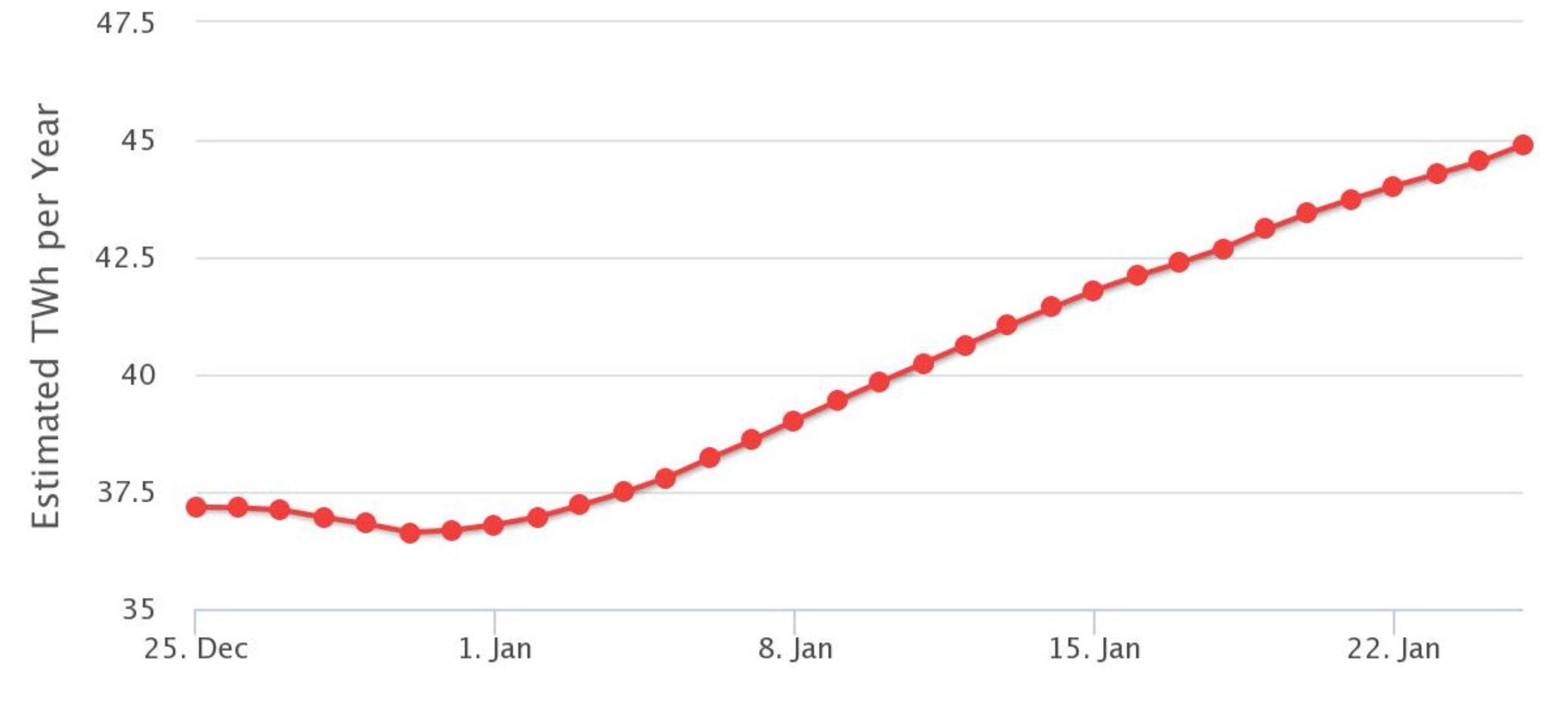If cryptocurrencies have a natural tendency to polarise opinion between their supporters and their critics, there’s one topic guaranteed to send temperatures rising—the energy consumption associated with the maintenance of the bitcoin and other cryptocurrency networks.
The miners responsible for maintaining the bitcoin blockchain—the immutable record of transactions in the currency since its inception—currently consume about 44 terawatt hours of electricity a year, according to researchers at Digiconomist. If bitcoin were a country, this would place it at around 50th in a list of the world’s most intensive energy consumers.
Bitcoin’s annual energy consumption

Source: Digiconomist, Bitcoin Energy Consumption Index
“Imagine,” the UK’s New Scientist publication wrote in November, “you discovered that in order to mint the coins and print the banknotes in your wallet, your country’s central bank employed vast numbers of people to push boulders up hills and let them roll down again.”
“If bitcoin fulfils its ambition to compete with, or even supersede, regular currencies issued by central banks, its wastefulness would amount to a scandal,” the magazine wrote in its leader column.
“By 2020 bitcoin will be using as much energy as the USA. It’s completely and utterly unsustainable,” Catherine Mulligan, co-director of the Imperial College Centre for Cryptocurrency Research and Engineering, said in an interview with BBC World Service in December.
To calculate the bitcoin network’s energy consumption, Digiconomist uses a top-down view, effectively extrapolating from the market price of the currency to estimate the blockchain’s power usage.
“By 2020 bitcoin will be using as much energy as the USA. It’s completely and utterly unsustainable.”
In its calculations, Digiconomist assumes that 60 percent of miners’ revenues—a figure that can be calculated from the current market value of the fixed coin reward accruing to the miner that calculates each new block in the chain, plus the aggregate transaction fees embedded in the block—is set aside for operational costs.
This amount is then converted, using a notional wholesale electricity price of 5 cents per kilowatt hour, into an assumed energy consumption rate.
Digiconomist says its method recognises the fact that calculating power usage from the bottom up—working out how many miners participate in the network, where they are located, how efficient they are and how much they pay for their energy—is guesswork.
By its nature, the bitcoin network has no central records. Bottom-up estimates of bitcoin’s energy usage also fail to take into account the costs of hardware and of cooling equipment.
Other economists have produced lower estimates of the bitcoin blockchain’s energy consumption rate. Researcher Marc Bevand, for example, uses a bottom-up analysis to arrive at a January 2018 estimate of 18 terawatt hours per year, 60 percent lower than Digiconomist’s estimate.
For some critics, any energy incurred on maintaining a cryptocurrency network is wasted.
“The proposed use cases of cryptocurrencies don’t justify the energy waste,” said Jordan Pearson, a cryptocurrency reporter and associate editor at VICE, speaking on BBC World Service in December.
“It seems less and less likely that bitcoin is going to be a way to pay for things. Instead, we now see people cheering bitcoin’s main function as a store of value. Quite honestly, I can’t think of a more damning indictment of how our economy creates value than just parking money in a system that is spun up out of unvarnished environmental waste.”
Others take a more nuanced view, pointing out that all monetary systems involve trade-offs.
“Any non-reversible computation, like the hash function used by bitcoin, consumes energy. So energy consumption is an inevitable fact of doing bitcoin mining,” says Joseph Bonneau, a postdoctoral researcher at Stanford University.
“But there’s a parallel to traditional mining: open-pit mines, used to source commodities such as gold, have been a huge source of concern for environmentalists over the years,” adds Bonneau.
“Energy consumption is an inevitable fact of doing bitcoin mining.”
In an article published in the St Louis Fed Q1 2018 quarterly review, researchers Aleksander Berentsen and Fabian Schär of Basel University’s Centre for Innovative Finance pointed out that the world’s fiat currency systems also carry important costs.
Although some criticise bitcoin for its use of massive amounts of computational power, say Berentsen and Schär, “from our perspective, the situation is not so clear-cut. Centralized payment systems are also expensive. Besides infrastructure and operating costs, one would have to calculate the explicit and implicit costs of a central bank.”
“Salary costs should be counted among the explicit costs and the possibility of fraud in the currency monopoly among the implicit costs. Moreover, many cryptoassets use alternative consensus protocols, which do not (solely) rely on computational resources.”
“Bail-outs and bail-ins are implicit costs of a centralised banking system.”
One can expand the cost-benefit analysis to include the costs to taxpayers of central bank-led interventions to head off financial crises, say Berentsen and Schär.
“Bail-outs (as well as bail-ins—think Cyprus) are [also] implicit costs of a centralised banking system,” they told New Money Review.
“The problem is that implicit costs are very hard to measure, especially when compared to something which can be estimated as easily as the cost of proof-of-work mining.”
Fiat currency systems may incur heavy human costs as well. In 2011, one researcher drew a direct parallel between the food price rises caused by the Federal Reserve’s quantitative easing programme, introduced to combat the effects of the 2008/09 financial crisis, and the “Arab spring” revolutions triggered that year.
Meanwhile, bitcoin mining has moved from being an activity easily conducted on a laptop at home, something possible in the currency’s early days in 2010/2011, to a highly specialised industrial operation, involving racks of specially designed computers operating in parallel.

A bitcoin mining farm
Source: 1stminingrig.com
Cryptocurrency commentator Matt Odell cites China, traditionally a centre of bitcoin mining, as an illustration of the changing economics of this activity. Some critics have associated bitcoin mining in China with dependence on electricity produced at heavily polluting coal-fired stations.
“Although China has a huge coal industry, the miners are now mostly situated near hydro-electric dams,” says Odell.
“This is because hydro producers have trouble storing electricity—they have roll-off times where the extra hydro power is priced very cheaply, say at 2 or 3 cents per kilowatt hour. In major US cities, by comparison, the price of electricity is 18-20 cents per kilowatt hour,” says Odell.
“As China is now cracking down on bitcoin exchanges and the mining industry, largely because of concerns about bitcoin potentially undermining the country’s capital controls, some miners are now moving to Canada, where they also have access to cheap hydro-electric power, as well as being offered tax breaks by the government,” says Odell.
“To have a secure, decentralised global financial network is a better use of electricity than most we can think of.”
Meanwhile, says Odell, the mining industry is reaping the benefits of technological advances.
“The efficiency of mining hardware is rising constantly and equipment is out of date after six months. And none of the big chip manufacturers have really entered the market yet.”
Odell, like many bitcoin supporters, turns the accusations of bitcoin’s energy wastage on their head.
“This could be one of the biggest paradigm shifts in the last hundred years. To have a secure, decentralised global financial network is a better use of electricity than most we can think of.”
And, says one computer scientist, bitcoin mining could have a revolutionary impact on the structure of global energy production.
“Bitcoin mining is performing valuable global arbitrage. It converts energy that would otherwise be wasted into a store of value.”
“Bitcoin mining is one of the few industries that is completely geographically independent,” says Andreas Antonopoulos.
“You can choose the location of your mining system based on the cheapest source of electricity. Around the world, the places and times where electricity are needed are almost never the places and times where the energy is available. Mining is performing valuable global arbitrage and is helping convert energy that would otherwise be wasted into a store of value.”
“The decentralisation of bitcoin is driving the decentralisation of energy production, which could be one of the most important trends in human history.”











Some argue that mining crypto could be positive for alternative energy producers, enabling them to turn excess energy not required otherwise to be turned into money, therefore leading to faster amortization (or higher return on investment) for the operator. Residential electricity needs peak in the morning and evening, while the sun peaks at noon, so there is a mismatch that cypto mining might be able to alleviate. Also, sun-rich but otherwise poor countries (Sahara) might be able to improve standard of living for their citizens by solar-powered mining.
Any non-reversible computation, like the hash function used by bitcoin, consumes energy. So energy consumption is an inevitable fact of doing bitcoin mining,” says Joseph Bonneau, a postdoctoral researcher at Stanford University.
What Joseph Bonnaeu is attempting to allude to is the fact that by Landauer’s principle, every bit erased costs k*T*ln(2) energy where k is Boltzmann’s constant (k=1.38*10^(-23) Joules/second), T is the temperature, and ln is the natural logarithm. By irreversible computation, Bonnaeu means a computation that deletes information while a reversible computation is a computation that does not delete any information. Landauer’s limit does not apply to reversible computation, and there are no theoretical limits to the energy efficiency of reversible computation. Bonnaeu however has committed the there-can’t-possibly-be-an-efficient-reversible-algorithm-that-does-so-and-so fallacy where he assumed that there cannot be any efficient completely reversible algorithm that mines Bitcoin.
1. Cryptocurrency mining problems are quite amenable to reversibility. After all, collision resistance is a weak form of reversibility, and the best way to ensure collision resistance is to incorporate reversible components into your cryptographic hash function.
2. If you look at the algorithm for SHA-256, you will notice that it contains many instances of modular addition, and modular addition can be computed using reversible ripple carry adders. SHA-256 is therefore quite amenable to reversible computation.
3. In this paper https://arxiv.org/pdf/math/9508218.pdf, you can see that any computation can be carried out in a completely reversible manner with a quite reasonable computational complexity overhead.
4. Any cryptocurrency mining problem can be mined reversibly with only a linear space/time overhead.
5. Before you state that Bitcoin mining cannot be done reversibly, perhaps you should write a program in the reversible programming language Janus so that you know how reversible computation works in practice.
I always have to correct people about this issue and it is getting really old really quickly.
On a related note, people still use SHA-256 as a cryptocurrency mining problem while SHA-256 mining has some bugs since it is susceptible to ASIC-BOOST, approximate mining, and it is an algorithm which was not designed for cryptocurrency mining. Instead, people should use a cryptocurrency mining problem which is specifically designed for cryptocurrencies instead of a mining problem with these bugs. I personally have designed such a mining problem myself which is optimized so that it will incentivize the development of the energy efficient reversible computer (in other words, people will build reversible computers in order to efficiently mine this cryptocurrency). Such a mining problem cannot be considered wasteful since the resources will be spent on a good cause.
I have contacted Bonnaeu’s colleagues about this issue, so there is no excuse.
-Joseph Van Name Ph.D.